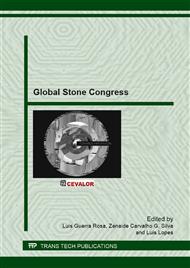[1]
R. Chandra: Slake durability test for rocks. Unpublished M.S. thesis, Department of Mining, Imperial Collage, England, 1970.
Google Scholar
[2]
J.A. Franklin and R. Chandra: The Slake Durability Test, International Journal of Rock Mechanics and Mining Sciences, 9 (1972) 325-341.
DOI: 10.1016/0148-9062(72)90001-0
Google Scholar
[3]
E. Kolay and K. Kayabali: Use of the fractal dimension method for determining the angularity and surface roughness of aggregates, Yerbilimleri, 26(2) (2004) 49-61.
Google Scholar
[4]
P.K. Sharma and T.N. Singh: A correlation between P-wave velocity, impact strength index, slake durability index and uniaxial compressive strength Bull Eng Geol Environ, 67 (2008) 17-22.
DOI: 10.1007/s10064-007-0109-y
Google Scholar
[5]
ISRM Suggested Methods: Rock Characterization, Testing and Monitoring. E. T. Brown (ed.), Permagon Press, London, 1981.
Google Scholar
[6]
ASTM Standard test method for slake slake durability of shales and similar weak rocks (D4644). Annual book of ASTM standards, vol 4. 08. ASTM, Philadelphia, 1990, pp.863-865.
DOI: 10.1520/d4644
Google Scholar
[7]
E. Kolay and K. Kayabali: Investigation of the effect of aggregate shape and surface roughness on the slake durability index using the fractal dimension approach, Engineering Geology, 86 (2006) 271–284.
DOI: 10.1016/j.enggeo.2006.05.007
Google Scholar
[8]
D.S. Agustawijaya: Modelled mechanism in the slake-durability test for soft rocks, Dimensi Teknik Sipil, 5(2) (2003) 87-92.
Google Scholar
[9]
E. Kolay, K. Kayabali and T. Beyaz: The effect of sample shape on the slake durability of some argillaceous rocks, ROCKMEC'2004-VIIth Regional Rock Mechanics Symposium, Sivas, Turkey, 2004.
Google Scholar
[10]
B. Sozmen: Investigation of detoration mechanism of Yazilikaya Tuffs in Midas Monument, MSc. Thesis, METU, Ankara, Turkey, 2000.
Google Scholar
[11]
G. Daloglu: Assessment of Eskisehir-Derbent tuffs as a natural building stone material, MSc Thesis, Eskisehir Osmangazi University, Eskisehir, Turkey, 2008.
DOI: 10.20319/lijhls.2017.32.2437
Google Scholar
[12]
A. Binal, K.E. Kasapoğlu andC. Gökçeoğlu: The surficial physical deterioration behaviour of Neogene volcanosedimentary rocks of Eskişehir-Yazılıkaya, NW Turkey, Engineering Geology and the Environment, Athens, Greece, P.G. Marinos, G.C. Koukis, G.C. Tsiambaos and G.C. Stournaras (eds.), A.A. Balkema, Rotterdam, 1997, pp.3065-3069.
Google Scholar
[13]
H. Ankara, M. Aksoy, S. Yerel and Y. Keser: A New Sample Preparation Method for Slate Durability Index Test, Proc. of 4th Balkan Mining Congress, Ljubljana-Slovenia, 2011, pp.571-576.
Google Scholar
[14]
C. Ayday and R.M. Göktan: Yazilikaya (MIDAS) Aniti Civarinda Gözlenen Kaya Blok Devrilme ve Kayma Mekanizmalari, Türkiye Jeoloji Kurultayı Bülteni, 8 (1993) 155-159.
Google Scholar


